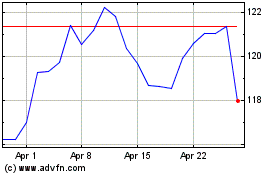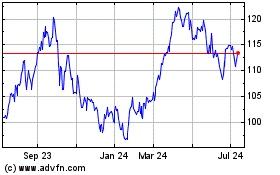Imperial Oil CEO: Expansion Of Pipeline From Canada Vital To US
March 10 2011 - 12:09PM
Dow Jones News
A pipeline project that's pending U.S. approval is necessary to
ensure the reliability and security of oil supplies to the world's
largest oil consumer, said the head of Imperial Oil Ltd. (IMO).
Imperial Oil is a Canadian company that's majority owned by
Irving, Texas-based Exxon Mobil Corp. (XOM), the world's largest
publicly traded oil company.
The Keystone pipeline system currently transports roughly half a
million barrels a day of oil from Canada's oil sands to the U.S.'s
biggest commercial storage hub in Cushing, Okla. A
multibillion-dollar expansion project, dubbed Keystone XL,
envisions another pipeline that would double the system's oil flows
from Canada, the No. 1 oil exporter to the U.S. Keystone XL would
also see the pipeline extend to the Gulf Coast, which would give
Canadian oil producers better market access to the largest refining
hub in the U.S.
Imperial Oil CEO Bruce Marsh noted that Canada, a "strong and
safe" democracy, represents half of the global oil reserves that
are open for private sector investment.
"That is an enormous driver, for countries, for companies...
Really, for anyone that looks to meet their growing energy needs,"
Marsh said in an interview on the sidelines of the annual IHS CERA
energy conference here in Houston.
Marsh's comments highlight the importance of Alberta's oil
sands, not only for Canadian oil companies, but also for oil giants
that see the region as the one of the last few opportunities for
relatively easy access to profitable crude oil.
They also come at a time when the turmoil in Libya and
subsequent disruption to oil supplies there have put the U.S.
economy's vulnerability to rising oil prices in stark relief.
In addition, oil traders are closely watching what happens to
the pipeline. Currently, there's few ways to get oil out of
Cushing. The onslaught of Canadian crude with no outlet has created
a glut, and depressed U.S. oil prices relative to other benchmarks.
On the Gulf Coast, Canadian oil would compete with blends of
similar quality from Mexico and Latin America.
Once Keystone XL is built, "you can go for many, many years
before the production capacity in the oil sands rises above the
limit" imposed by pipeline capacity, Marsh said.
There's some uncertainty as to when or even if the expansion
will become a reality. The pipeline, owned by TransCanada Corp.
(TRP, TRP.T), has become a lightning rod for criticism of the oil
sands. Crude oil there is more expensive to extract, and requires
an energy-intensive process that results in more carbon-dioxide
emissions. A decision on Keystone XL by the State Department,
expected in the second half of this year, also comes amid a spate
of high-profile pipeline ruptures and explosions across the
U.S.
Last month, TransCanada raised its the cost estimate for the
expansion and said it expected a decision by the State Department
to be delayed due to "a heightened political environment and
opposition to the project."
Marsh said that if the Keystone expansion is approved, it would
lessen the urgency for a proposed West Coast pipeline to ship oil
to the Pacific. But over the long term, the Canadian oil industry
would appreciate the flexibility of being able to ship to markets
other than the U.S.
Marsh said that the industry is working hard to reduce its
carbon footprint. Imperial and Exxon's Kearl oil sands mining
project, scheduled for start-up in late 2012, will likely be the
first operation to showcase that reduction.
"When we get done it will be no worse than the average of all
the crude oils," Marsh said. "It'll be an achievement."
Kearl will initially produce about 110,000 barrels a day, and
has regulatory approval for up to 345,000 barrels a day. This crude
will be priced off oil benchmarks tied the U.S. Midcontinent. But
these prices have been well below that of Brent, a European
benchmark that's being viewed increasingly as a better global
indicator.
Marsh said he wasn't concerned about the disparity. "I wouldn't
call it an issue at all," he said.
-By Angel Gonzalez, Dow Jones Newswires; 713-547-9214;
angel.gonzalez@dowjones.com
Exxon Mobil (NYSE:XOM)
Historical Stock Chart
From Apr 2024 to May 2024

Exxon Mobil (NYSE:XOM)
Historical Stock Chart
From May 2023 to May 2024
